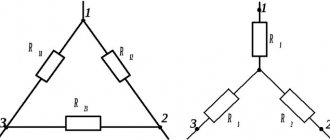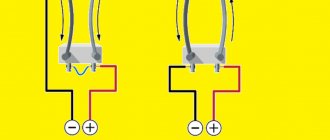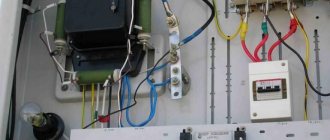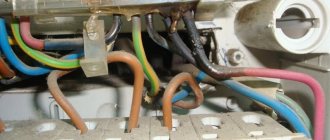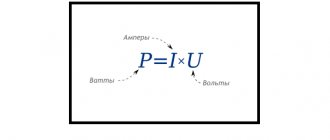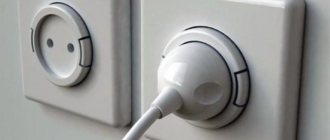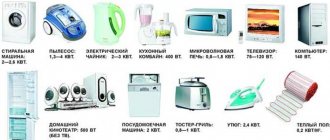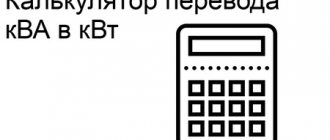From my personal experience, I was convinced how difficult the process of selecting sockets and plugs for household electrical appliances is, not to mention the selection of electrical wiring, switches and automatic machines. An ordinary user who has no idea about electricity can easily make a mistake with dire consequences.
To eliminate the possibility of errors, you need to either study this issue, as I did, or use tables with data.
I’ll start from the very beginning, namely why you need to find out how much power there is in kilowatts in amperes. And this is necessary because on sockets, plugs, fuses and other electrical wiring elements they write symbols in amperes, showing how much current this element can withstand, and in mechanisms they indicate the power in watts or kilowatts, thereby forcing people to independently calculate which device to use. which electrical wiring is suitable, and vice versa.
To make it clearer, to connect a 100 W light bulb you need one circuit breaker, but to connect an electric stove you need a completely different circuit breaker, like all other elements (electric cable, socket, plug, fuse, etc.), this is the difference.
To compare power in watts and current in amperes, you need to convert the values from one to the other.
For alternating voltage, calculations are quite simple; you just need to use the conversion formula, where in addition to current and power, voltage is also added.
This calculation formula is only suitable for a single-phase network
Wherein:
- A is Amps
- W is Watts
- V is for Volts
Example 1 is the simplest, let’s say your network voltage is 220 Volts, and the device is 220 Watts, which means to find amperes you need to divide 220 Watts by 220 Volts, we get 1 Ampere.
Example 2 is more complex, let’s say the mains voltage is 220 Volts, and you have a 600 Watt coffee grinder, which means 600 Watts must be divided by 220 Volts, we get 2.73 Amperes. This means that the coffee grinder needs to be wired at least 3 Amperes.
Example 3 condition of the question, we know that we have 1 Ampere and there are 220 Volts, we need to find how many kilowatts it is, which means we need to multiply 1 Watt by 220 Volts, we get 220 Watts.
To convert Watt to kiloWatt, you need to divide by 1000, we get that 220/1000 = 0.22 kW.
So the answer to your question is:
Ampere to kilowatt ratio
The ampere is considered a unit of electrical current in the international system, or the force of electric current penetrating through a conductor element in the amount of one coulomb per second.
Definition of ampere and kilowatt
Kilowatt is a subunit of watt and a power measurement unit, as well as heat flux, sound energy flux, active and apparent power of alternating electric current. These are all scalar units of measurement in the international system that can be converted.
Note! As for the ratio of these indicators, 1A contains 0.22 kW for a single-phase circuit and 0.38 for a three-phase circuit. Correlation of measured quantities
Correlation of measured quantities
Historical excursion[ | ]
The unit of measurement "volt" was introduced in 1861 by the Electrical Standards Committee created by William Thomson. Its introduction was related to the current needs of engineering physics. On June 1, 1898, by imperial law in Germany, 1 volt was established as the “legal” unit of measurement of EMF, equal to the EMF exciting a current of 1 ampere in a conductor with resistance 1 [13]. The volt was introduced into the International System of Units (SI) by the decision of the XI General Conference on Weights and Measures in 1960, simultaneously with the adoption of the SI system as a whole [14].
Until 1990, 1 volt was defined in terms of the energy unit joule and the charge unit coulomb.
How much does an electric boiler consume?
Electric boilers are installed in houses for heating and water heating. However, the simplicity of the design and ease of operation hides high energy consumption. Models of electric boilers differ in power, design, number of circuits and method of heating the coolant (heating elements, electrode or induction heating). Double-circuit boilers are used for heating and water heating. Boiler models are more economical than flow-through ones.
The choice of boiler is made on the basis of the required power that it must have to ensure heating of premises of a given area. When calculating, it should be taken into account that kW is the minimum power of the device required to heat 10 sq.m. of room area. Additionally, climatic conditions, the presence of additional insulation, the condition of doors, windows, floors and the presence of cracks in them, and the thermal conductivity of walls are taken into account.
Note! The final power of an electric boiler is influenced by the method of heating the coolant, while electrode devices are able to heat a large area while consuming less electricity.
To determine the electricity consumption of an electric boiler, it is necessary to calculate its operating mode. It should be borne in mind that the device will operate at full capacity for half the season. The duration of its operation per day is taken into account. Thus, to determine the total electricity consumption per day, it is necessary to multiply the number of hours by the power of the device.
Double-circuit boilers consume electricity in both winter and summer.
To reduce the cost of energy consumption of the boiler, you should install a two-phase meter, according to which electricity is calculated at night at a reduced tariff. It will also save money by using an automatic control device for electrical appliances, which will control the operation of the device based on the time of day.
What voltage is measured in volts and watts
Voltage in watts or volts is measured according to individual criteria. Voltage measurements are carried out in Volts, and in the drawings it is indicated by the letter V. The voltage is measured by a device - a voltmeter. The latest devices may be:
- Analog.
- Digital.
The first ones are more accurate.
Portable devices have voltmeters built into them, and these tools are used by electricians. Analog devices are installed on electrical panels: switchboards and generators. The latest equipment comes complete with digital meters.
The voltage value in accordance with international standards is established:
- Kilovolt – kV.
- Millivolt – mV.
- Volt - V.
- Megavolt - MV.
- Microvolt - µV.
Voltage measurements
Important! Power is measured in watts (kilowatts). This value is directly proportional to the voltage, as well as to the magnitude of the current
The main difference is the designation of established indicators, according to the measurement system.
Multiples and submultiples of volts:
Multiples and submultiples are formed using standard SI prefixes.
| Multiples | Dolnye | ||||||
| magnitude | Name | designation | magnitude | Name | designation | ||
| 101 V | dekavolt | yesV | daV | 10−1 V | decivolt | dV | dV |
| 102 V | hectovolt | gV | hV | 10−2 V | centivolt | SV | cV |
| 103 V | kilovolt | kV | kV | 10−3 V | millivolt | mV | mV |
| 106 V | megavolt | MV | MV | 10−6 V | microvolt | µV | µV |
| 109 V | gigavolt | GW | G.V. | 10−9 V | nanovolt | nB | nV |
| 1012 V | teravolt | TV | TV | 10−12 V | picovolt | pV | pV |
| 1015 V | petavolt | PV | PV | 10−15 V | femtovolt | fV | fV |
| 1018 V | exavolt | EV | EV | 10−18 V | attovolt | aB | aV |
| 1021 V | zettavolt | ZV | ZV | 10−21 V | zeptovolt | zV | zV |
| 1024 V | iottavolt | IV | YV | 10−24 V | yoctovolt | iB | yV |
Volt.
Volt is a unit of measurement of electrical potential, potential difference, electrical voltage and electromotive force in the International System of Units (SI). Volt as a unit of measurement has a Russian designation - V and an international designation - V.
Volt as a unit of measurement
Application of Volt
Representation of volts in other units of measurement - formulas
Multiples and submultiples of the volt
Interesting examples
Other units of measurement
Calculation
Special formulas are used to calculate values. After counting them, all that remains is to insert them into the above formulas. To find the electric current, you need to divide the voltage by the conductor resistance, and to find the power, you need to multiply the voltage by the current force or double the current value by the resistance. It is also possible to divide the double voltage value by the resistance.
Note! Often all the necessary data is written on the box or technical specifications on the manufacturer’s website. Often the information is indicated in kW and can easily be converted to amperage using a converter
Another easy way to determine energy consumption and amperage is to examine the consumer's electric meter or circuit breaker. But in this case, it is necessary to connect only one device to the network.
Calculation formula
How to use an online calculator
Knowing the current parameters, you can independently calculate such an important parameter as power. This value determines the rate of energy consumption per unit of time, so you can calculate additional costs and load on the network when the device is turned on.
What information will you need to enter:
- Mains voltage, which may also vary. Car wiring is usually designed for 12 V voltage. On older models, the indicator is still 6 V, and on large vehicles - 24 V (buses or trucks with diesel engines).
- Rated current, the value of which can usually be found from the technical data sheet of the equipment. Typically, such information is placed directly on the device body.
The intuitive interface of the calculator will allow you to quickly convert amperes to kilowatts and perform other similar operations. The service will allow you to quickly convert the power consumption of electrical appliances in order to calculate the load on the network. In addition, such a calculator will provide car owners with complete information about the consumed power of the electrical network. This will allow you to easily select a new battery and replace individual electrical wiring components.
Number of insulators on power lines (in the overhead line corridor)
The number of insulating insulators in ground waveguides on metal and reinforced concrete carriers in clean air (with normal air pollution).
| Type of insulator according to GOST | 35 kV power line | 110 kV | 150 kV overhead line | 220 kV overhead line | 330 kV overhead line | 500 kV |
| PF6-A (P-4.5) | 3 | 7 | 9 | 13 | 19 | — |
| PF6-B (PM-4.5) | 3 | 7 | 10 | 14 | 20 | — |
| PF6-B (PFE-4.5) | 3 | 7 | 9 | 13 | 19 | — |
| (PFE-11) | — | 6 | 8th place | 11 | 16 | 21 |
| PF16-A | — | 6 | 8th place | 11 | 17 | 23 |
| PF20-A (PFE-16) | — | — | — | 10 | 14 | 20 |
| (PF-8.5) | — | 6 | 8th place | 11 | 16 | 22 |
| (R-11) | — | 6 | 8th place | 11 | 15 | 21 |
| PS6-A (PS-4.5) | 3 | 8th place | 10 | 14 | 21 | — |
| PS-11 (PS-8.5) | 3 | 7 | 8th place | 12th place | 17 | 24 |
| PS16-A | — | 6 | 8th place | 11 | 16 | 22 |
| PS16-B | — | 6 | 8th place | 12th place | 17 | 24 |
| PS22-A | — | — | — | 10 | 15 | 21 |
| PS30-A | — | — | — | 11 | 16 | 22 |
How many volts are in 35 kV?
Low voltage lines are LEP-35 kV (voltage 35,000 volts) it is easy to identify the most visual ones, because.
Interesting materials:
How to feed flowers with hydrogen peroxide? How to increase the average check in a grocery store? How to increase sales in a grocery store? How to sign a business letter? How to sign an electronic contract? How to sign a signature? How are types of tea classified according to preparation technology? How to trim grapes? How to confirm an invoice in UTM? How to confirm the purchase of beer in EGAIS?
Refrigerator: how many watts does it consume per hour?
When answering the question of which electrical appliances consume the most energy, the refrigerator will be first on the list. This device works around the clock. The actual energy consumption of the refrigerator is calculated taking into account the international classification of energy efficiency devices. This parameter is designated by a letter with a certain number of pluses; the more there are, the lower the level of electricity use.
The classification of a household appliance by energy efficiency is as follows:
- A++ - the highest class with maximum energy saving. Electricity consumption is 30% of the standard value;
- A+ - energy consumption - 30-42% of the standard;
- A - energy consumption - 42-55% of the standard;
- B - energy consumption - 55-75% of the standard;
- C – energy consumption – 75-90% of the standard;
- D – energy consumption – 90-100% of the standard;
- E - energy consumption - 100-110% of the standard;
- F - energy consumption - 110-125% of the standard.
However, the energy efficiency parameter is very average. Since the amount of electricity consumed by the refrigerator is affected by its operating mode, workload, and the number of door openings.
The refrigerator consumes the largest amount of energy among all electrical appliances. Note! The instructions for the refrigerator indicate the energy efficiency class and the amount of electricity it consumes per hour.
Annual energy consumption corresponds to 220-460 kW. It is impossible to obtain an accurate result for a table of electricity consumption per day or month by simply dividing this value. Since energy consumption is influenced by a number of factors, such as freezing power, ambient temperature, and product filling level.
To reduce the energy consumption of the refrigerator, it is necessary to operate the device correctly, do not leave the internal space empty when it is turned on, do not open the door for a long time, do not put hot food in, check the condition of the seals, ensure that there is a gap between the refrigerator and the wall, regularly defrost, wash and dry the unit.
Interesting examples*:
The smallest measurable voltage is about 10 nV.
The potential difference on the neuron membrane is 70 mV.
The voltage on a regular AA AA battery is 1.5 V (constant).
The power supply for computer components has a voltage of 5 V, 12 V (constant).
The electrical equipment voltage for cars is 12 V, for heavy trucks – 24 V (DC).
The voltage in car batteries is 12/24 V (constant).
The voltage in the power supply of the laptop and LCD monitors is 19 V (DC).
“Safe” reduced voltage in the network in hazardous conditions is 36-42 V (AC).
The voltage in the telephone line (with the handset down) is 50 V (constant).
The voltage in the Japanese electrical network is 100 / 172 V (three-phase alternating).
Voltage in US home electrical networks is 120 / 240 V (split phase) (three-phase alternating).
The voltage in household electrical networks in Russia is 220/380 V (three-phase alternating).
The discharge of the electric ramp is up to 200-250 V (constant).
Electric eel discharge – up to 650 V (continuous).
The voltage on the car's spark plug is 10-25 kV (pulse).
The voltage in the contact network of a tram and trolleybus is 600 V (660 V) (constant).
The voltage of the contact rail in the subway is 825 V (DC).
The voltage in the railway contact network is 3 kV (DC), 25 kV (AC).
The voltage in the main power lines is 110, 220, 330, 500, 750 and 1150 kV (three-phase alternating).
The highest DC voltage obtained in the laboratory is 25 MV.
Lightning has a voltage of 100 MV and above (constant).
* The type of voltage is indicated in parentheses.
Note: Photo https://www.pexels.com, https://pixabay.com
Site Map
voltage how much power 1 380 5 6 18 12 220 volts online store buy battery screwdriver catalog transformer 2 3 24 volts lamp LED power supply volt price circuit St. Petersburg current generator converter do it yourself
Demand factor 440
Converting kilowatts to amperes (single-phase 220V network)
How to convert watts to amperes:
- make a list of all consumers: 5 LED lamps of 15 W each, heater 2.3 kW, laptop 120 W;
- recalculate into a single format: 2.3 * 1000 = 2,300 W;
- sum up the obtained values: 75 2 300 120 = 2 495 W;
- calculate the total current when all consumers are connected simultaneously:
I (current) = P (power) / U (voltage) = 2,495 / 220 = 11.34 A.
Select the machine with the nearest higher nominal value. For this example, a 16 A protective device is suitable. The serial product is designed for a load power of up to 3,500 W, which more than covers the existing needs. The power supply network is made of copper (aluminum) conductors with a cross-sectional area of 1.5 (2.5) square meters. mm, respectively.
How much electricity does a kettle consume?
An electric kettle is a convenient household appliance that can provide its owners with boiling water in a matter of minutes.
It is necessary to calculate how many kilowatts a kettle consumes, taking into account the power of the device and the maximum volume of liquid that it can bring to a boil. The larger the displacement of the device, the more time it will take to heat the water, and accordingly the amount of electricity consumed increases. On the other hand, the high power of the kettle contributes to its fast operation. However, it requires a sufficient amount of electricity.
All electric kettles are different in their parameters and, accordingly, in their level of energy consumption.
To calculate how much a kettle consumes, you should perform the following calculations:
- The power of the device is taken from the passport;
- the time it takes to boil water in the kettle is calculated;
- electricity consumption per unit time is determined;
- the resulting value should be multiplied by the number of times the water is boiled;
- monthly electricity consumption is determined.
Based on the table, the power of the electrical appliance is in the range of 700-3000 W, which depends on the volume of the bowl, body material, displacement, type of heating element, and chemical composition of the water. The heating element can be open (spiral) or closed (plate) type. The first option provides a high rate of water heating and, accordingly, uses less energy.
The energy consumption of the device is also influenced by the housing material. In a metal bowl, water heats up faster. However, an additional amount of electricity is spent on heating the case. Glass also heats up quickly, but retains heat less well. Ceramic has a slow heating rate, but the water in the kettle will remain hot for a long time.
Note! Boiling water in an electric kettle is less expensive than using an electric stove. If you pour a minimum amount of water into the kettle without reserve, you can reduce the waste of both water and electricity. To reduce the kettle's energy consumption, unplug the appliance from the outlet when not in use.
The required volume of water should be poured into it, without reserve. You should monitor the condition of the heating element by regularly descaling it
To reduce the kettle's energy consumption, unplug the appliance from the outlet when not in use. The required volume of water should be poured into it, without reserve. You should monitor the condition of the heating element by regularly descaling it.
How to convert volts and watts and vice versa
To correctly complete the task associated with converting volts to watts, you can follow the following algorithm:
- You need to find the power value in the operating manual of the electrical appliance. Companies often indicate this value in volt-amperes. This symbol indicates the maximum amount of electricity consumed. So it is equal to the power value.
- Determine the efficiency of the power source based on the design features and the number of devices connected to it. As a rule, this coefficient is set in the range from 0.6 to 0.8.
- Convert current-voltage indicators to W: find out the active power of energy equipment designed to supply uninterruptible power.
Important! Calculate the number of watts by multiplying volt-amperes by efficiency. Visual representation of voltage and current
Visual representation of voltage and current
Conversion from W to V follows the reverse pattern: watts must be divided by the efficiency factor.
When choosing a power source from the manufacturer, it is not always clear how much power the device produces. Therefore, it is recommended to study the technical parameters specified in the instructions in order to carry out the correct conversion from one value to another.
Differences between "kVA" and "kW"
Sometimes on the surface of the device panel or in its description, kVA is used instead of the traditional kW for electrical power. In order for the consumer to be able to determine what value in kVA he needs, he should know that they measure the full value of the quantity, and in kW - the active value.
The total power indicator includes everything that the power source transmits externally, but it is not necessarily completely spent on doing the work. One of its fractions (active) performs work or is transformed into thermal form, the other (reactive) is redirected to the electromagnetic field available in the network. These are different quantities, although they have identical dimensions. In order not to confuse them, volt-amperes, rather than watts, are used to measure the full indicator. The pragmatic meaning of apparent power is that it describes the actual loads created by the consumer on the components of the electrical network. After all, these loads depend on how much current is consumed. Because of this, it is customary to use the volt-ampere value to indicate the power rating of switchboards and transformer devices.
When choosing a power source, it is often not clear to the consumer how much power it can actually provide. This is due to the fact that the technical parameters of such devices record the full power value in VA, and knowledge of how VA and W are related is required.
How to reduce energy consumption of household appliances
To reduce the electrical energy consumption of household appliances, there are several effective techniques. A good result is achieved by using an energy-saving refrigerator that can operate in this mode all year round, regardless of weather conditions.
It is better to organize the lighting system in the house using modern LED or energy-saving lamps. Their installation will not only save energy, they are also characterized by a longer operating period. A good effect is achieved by installing local lighting in the kitchen, bedroom, hallway, and living room, which also saves energy.
Note! The use of extension cords and adapters increases power consumption.
Refrigerators and freezers should be defrosted promptly. The presence of excess ice on the internal walls of devices increases energy consumption.
Tips for saving energy consumption.
While the computer is running, you can select the optimal power consumption mode for it. It will automatically turn off when left idle for a certain period of time. When exiting sleep mode, much less energy will be needed compared to normal switching on.
On a note! It will be possible to reduce energy costs by installing a multi-tariff meter, the night and day readings of which are calculated at different tariffs. At night the cost of electricity is lower.
When operating heating devices, you can use heat-reflecting screens, which help increase heat transfer and reduce energy consumption.
When choosing household appliances, you should consider how many watts (kilowatts) the appliance consumes per hour. It is better to give preference to economical devices that will meet the stated requirements, while saving the energy resources necessary for their operation.
Definition based on the Josephson effect[ | ]
A matrix of Josephson junctions developed by the National Standards Institute to reproduce the standard volt.
Since 1990, the volt has been standardized through measurement using the time-dependent Josephson effect, which uses the Josephson constant, codified by the 18th General Conference on Weights and Measures as a reference to the standard.[4]
K J-90 = 2 eh = {\displaystyle K_{\text{J-90}}={\frac {2e}{h}}=} 0.4835979 GHz/μV,
where e
is the elementary charge,
h
is Planck’s constant.
By this method, the value of a volt is unambiguously associated with the frequency standard set by a cesium clock: when a matrix consisting of several thousand Josephson junctions is irradiated with microwave radiation at frequencies from 10 GHz to 80 GHz, a well-defined electrical voltage arises, with the help of which voltmeters are calibrated[5] . Experiments have shown that this method is insensitive to the specific implementation of the installation and does not require the introduction of correction factors [6].
Differences
Active power is measured in kilowatts, and total or nominal power is measured in kilovolt amperes. Volt ampere with kilovolt ampere, being a power unit of current, is calculated as the product of current ampere values in an electrical circuit and the volt voltage at its ends. A watt per kilowatt is the energy accomplished per second and is equal to one joule. The measurement is carried out using the force of constant energy at a volt voltage.
Note! Only a part of the device’s power is involved at the time of work activity. The rest comes out
How do the values differ?
What is the difference between W and V (V and A)
What is the difference between a volt and an ampere: Volt is a unit of measurement of voltage, and watt is a unit of power. V is the difference created in the electrical potential across a wire line when a current of 1A dissipates a unit of power, i.e. voltage. The definition of voltage is that it is the potential of electricity between different points. Along with this, it is used to indicate the difference in potential energy of an electric charge between points. An energy source is a voltage that represents expended or lost energy.
About power
Attention! Voltage is hypothetically similar to the pressure created in a circuit, pushing electrons through. The passage of current must be ensured on two paths
This characteristic is considered the total energy for moving the charge. The determination of voltage is based on the fact that negative charges are attracted to high values, and positive charges to low values.
The passage of current must be ensured on two paths. This characteristic is considered the total energy for moving the charge. The definition of voltage is based on the fact that negative charges are attracted to high values, and positive charges to low values.
W – speed of work. The speed is maintained at 1 meter per second against a constant reaction force of 1 newton. If we consider it in relation to electromagnetism, the unit is the rate of work done when 1 ampere passes through a potential difference of 1V. Watt is a measure of power.
Power
Power is the energy flow with which energy is consumed. It happens that in the description of a device it appears instead of kW - kVA. To determine this value, you need to know what is measured in kVA.
No energy is expended to complete the work, but on the contrary:
- One of the factions becomes active, that is, it performs work or transforms into another form.
- The other faction is reactive. The energy is directed into an electromagnetic field.
Attention! These quantities are different, despite the same proportionality. To avoid confusion, the indicator is measured not in watts, but in volt-amperes
Mechanical power
Volt as a unit of measurement:
Volt is a unit of measurement of electrical potential, potential difference, electrical voltage and electromotive force in the International System of Units (SI), named after the Italian physicist and physiologist Alessandro Volta.
Volt as a unit of measurement has a Russian designation - V and an international designation - V.
There are several definitions of volt.
The potential difference between two points is equal to 1 volt (V), if in order to move a charge of 1 coulomb (C) from one point to another, 1 joule (J) of work must be done on it.
1 volt (V) is equal to the electrical voltage that produces a direct current of 1 ampere (A) at 1 watt (W) in an electrical circuit. Or 1 volt is equal to the electrical voltage at the ends of the conductor required to release heat in it with a power of one watt (W) when the direct current flowing through this conductor is one ampere (A).
1 volt (V) is equal to the potential difference across a 1 ohm resistor (Ω) when a current of 1 ampere (A) flows through it.
B = (m² kg) / (s3 A) = J / C = W / A = A Ohm.
1 V = (1 m² 1 kg) / (1 s3 1 A) = 1 J / 1 C = 1 W / 1 A = 1 A 1 Ohm.
The volt was introduced into the International System of Units by the decision of the XI General Conference on Weights and Measures in 1960, simultaneously with the adoption of the SI system as a whole. In accordance with the SI rules regarding derived units named after scientists, the name of the unit “volt” is written with a lowercase letter, and its designation is written with a capital letter (B). This spelling of the designation is also preserved in the designations of derived units formed using the volt.
Converting kVA to kW and vice versa
In layman's terms, the difference between kW and kVA is that kW is useful and kVA is total power. According to the following example of converting values kVA-20%=kW and 1=0.8 kW. To convert ampere to kW, subtract twenty percent from the first value. The result will be an indicator with a small error. For example, if a household stabilizer has a power of 15, then to calculate kilowatts, you need to multiply this value by 0.8 or subtract 20% from it. Then you can recalculate everything using online converters. As a result, you need to follow a simple formula:
P=S * Cosf, where P is the active power, S is the apparent power, Cos f is the power coefficient.
Conversion formula
To reverse the action and calculate kilovolts, for example, on a 10 kilowatt portable generator, you need to divide this value by 0.8, according to the formula below:
S=P/ Cos f, where S is considered the total power, P is the active force, and Cos f is the power coefficient. More detailed background information is given in any physical textbook, including the answer to the question of how to convert the power of a 1000 kVA transformer into kW.
Formula for converting kW to kVA
It is worth noting that the most common interpretations of the power coefficient are the following values: 1 is the optimal value, 0.95 is good, 0.90 is satisfactory, 0.80 is average, 0.70 is low and 0.60 is bad. Therefore, converting the power of a 1000 kVA transformer into kilowatts is not difficult.
Power coefficient values
Answering the question what is the difference between kilowatt and kilovolt, we can say that these are two different quantities. In the first case, this is a unit of measurement for total power, and in the second, only active power. Their difference is manifested in the operation of electrical equipment, despite the possible similarity in the writing of quantities.
Total power in W: how much energy do household appliances consume in kW
Any apartment is equipped with the necessary set of household appliances and electrical equipment. Each type of equipment has individual technical characteristics, including power and energy consumption. The total value of all these factors determines the total amount of electrical energy consumed, which will be different for each family.
Distribution of energy consumption by electrical appliances as a percentage.
In order to plan possible expenses, some owners resort to compiling a table of electricity consumption by household appliances per hour, where they indicate the name of the consumer, its power and duration of operation throughout the day. Information about the total energy consumption of household appliances and lighting elements is necessary for installing switching and protective equipment and selecting the cross-section of electrical wiring.
On a note! To determine the total power, the corresponding consumer values must be converted into one unit of measurement, so it is important to know how many W are in 1 kW.
From the table below you can conclude which household appliances consume more electricity. These include a lighting system, refrigerator, TV, computer, washing machine, electric kettle and iron. The total value averages 120-180 kW per month. Additional costs include the use of small household appliances in the form of a hair dryer, coffee maker, food processor, chargers and other elements that provide the required level of comfort. In the summer, the use of air conditioning is also taken into account, and in winter - oil electric heaters, which add 60-100 kW.
Energy consumption table for household appliances
For each home, the number of electrical devices, the value of their electricity consumption and the duration of operation will be different. The table below for energy consumption of household appliances contains average information:
| Device name | power, kWt | Operating time per day, h | Consumption per day, kWh | Consumption per month, kWh |
| Fridge | 0,15-0,6 | 24 | 3,6-8,6 | 10,8-25,8 |
| Lighting (10 lamps 20 W each) | 0,020 | 5 | 0,1 | 3 |
| Washing machine | 1-2,2 | 1 | 1-2,2 | 20-30 |
| Vacuum cleaner | 0,65-2,2 | 15 minutes | 0,16-0,55 | 1,6-5,5 |
| TV | 0,1-0,3 | 5 | 0,5-1,5 | 15-30 |
| Microwave | 1,5 | 30 minutes | 0,75 | 10-15 |
| Electric kettle | 0,7-3 | 15 minutes | 0,25-0,75 | 7,5-16,5 |
| Computer | 0,1-0,2 | 5 | 0,5-1 | 7-20 |
| Iron | 1,1 | 15 | 0,3 | 5-8 |
| Dishwasher | 0,5-2,8 | 1 | 0,5-2,8 | 7,5-15 |
| Multicooker | 0,2-2,4 | 1 | 0,2-2,4 | 2-24 |
| Food processor | 0,2-2,0 | 15 minutes | 0,05-0,5 | 0,5-3 |
| Air conditioner | 0,7-1,3 | 7 | 3,5-8 | 15-35 |
| Hairdryer | 1,2-1,5 | 15 minutes | 0,3-0,4 | 5-7 |
| Heater | 1,5 | 5 | 7,5 | 75 |
| Electric stove | 2-8,5 | 3 | 5-10 | 30-150 |
| Coffee maker | 1,5-3,5 | 15 minutes | 0,3-0,8 | 5-10 |
| Hood | 0,1-0,5 | 3 | 0,3-1,5 | 3-4,5 |
Conversion table from volt-amperes to watts
Power losses when connecting a certain load are determined by the correction factor cos ϕ. With linear parameters (incandescent lamps, heating elements), the energy is almost completely used for useful work. In electric motors, reactive components degrade performance characteristics.
The cos ϕ value is indicated in the accompanying documentation:
- 0.6-0.7 – worst indicators;
- 0.8-0.9 – average;
- 1 – minimal losses.
When connecting several devices, make a table for convenience. The calculation is made taking into account the active and reactive components.
Determining voltage by appearance
The next stage is determining the power of overhead lines.
How can you find out the voltage on a power line by its appearance? The easiest way to do this is by the number of wires and the number of insulators. The easiest way is to determine by insulators.
There are overhead lines of different voltage classes. Let's look at each one in turn.
Power lines of 0.4 kilovolts (400 Volts) are low-voltage, found in all populated areas. They always use porcelain or glass pin insulators. The supports are made of reinforced concrete or wood. There are two wires in a single-phase line. If there are three phases, there will be four or more conductors.
Next come power lines for 6 and 10 kilovolts. Visually they are indistinguishable from each other. There are always three wires here. Each uses two porcelain or glass pin insulators or one of a higher value. These routes are used to supply power to transformers. The minimum distance to current-carrying parts here is 0.6 m.
Often, in order to save money, they combine the suspension of 0.4 and 10 kV conductors. The security zone for such routes is a distance of 10 m.
In power lines with a voltage of 35 kV, suspended insulators are used in quantities of 3 to 5 pieces in a garland for each of the three phase wires.
Typically, such air routes do not pass through urban areas. The acceptable distance is 0.6 m, and the security zone is defined as 15 meters. The supports must be reinforced concrete or metal, with current-carrying conductors spaced apart from each other at an acceptable distance.
In power lines with a voltage of 110 kV, each wire is installed on a separate garland of 6-9 suspended insulators. The minimum distance to the conductors is 1 meter, and the security zone is defined as 20 meters.
The material for the support is reinforced concrete or metal.
If the voltage is 150 kV, use 8-9 suspended insulators for each garland in the power line. A distance of 1.5 m to current conductors is considered minimal in this case.
When the voltage is 220 kV, the number of insulators used ranges from 10 to 40 units. The phase is transmitted over one wire.
The lines are used to supply electricity to large substations. The shortest distance to approach the conductors is 2 m. The size of the security zone is 25 m.
In subsequent classes of high-voltage power lines, a difference appears in the number of wires per phase.
If two conductors are installed per phase, and there are 14 insulators in garlands, you have a 330 kV main line.
The minimum distance to live parts in it is considered to be 3.5 m. The necessary increase in the security zone is up to 30 m. The material for the supports is reinforced concrete or metal.
If a phase is split into 2-3 conductors, and there are 20 suspended insulators in garlands, then the overhead line voltage is 500 kV.
The security zone in this case is limited to 30 meters. A distance of less than 3.5 m to the wires is considered dangerous.
In the case of a phase division into 4 or 5 conductors, the connection of which is ring or square, and the presence of 20 or more insulators in the garlands, the overhead line voltage is 750 kV.
The protected area of such routes is 40 m, and approaching live parts closer than 5 m is dangerous to life.
Russia has the only power line in the world with a voltage of 1150 kV. The phases in it are divided into 8 wires each, and the garlands contain 50 or more insulators.
You should not approach this route more than 8 meters. You can see such a high-voltage line, for example, on the section of the Siberia - Center highway.
You can get detailed information about any overhead line and its location on an interactive map on the Internet.
How many kilowatts in 380 volts?
What are three phases? First, a few words about what we actually mean. When we talk about a village network, that is, about a power line that runs along the street and from which houses are connected, then we are talking about lines of the 0.4 kilovolt (kV) category. This group includes voltage networks of 220V (0.22 kV) and 380V (0.38 kV).
Interesting materials:
How many barrels does Russia produce per day? How many barrels does Russia sell per day? How many polar bears are left in Russia? How much will 100 thousand from Russia be in Belarusian ones? How much will the PlayStation 5 cost in Russia? How much will ps5 cost in Russia? How many generalissimos were there in Russian history? How many hours is the difference between Russia and America? How many time zones are there in Russia? How much money can you export from Uzbekistan to Russia?
Conversion table
At the moment, you can convert values in forward and reverse order without any problems thanks to a special table called “100 amperes how many kilowatts”. Using it you can easily calculate the required values. It is especially convenient to use when you need to count large numbers. Interestingly, today there are tables designed to calculate the amperage and energy of a single-phase and three-phase circuit breaker. Standard data for those devices that can be purchased on the market today are provided.
Conversion table for kilowatts and amperes
To find out the necessary data, you need to use the above formulas or use a translation table. These measurement values will help you calculate the energy used by a specific device and make other calculations in the electrical field.
How to convert watts to amperes - instructions.
The formula we need looks like this:
P=I*U
The following indicators are used here:
- P – power (W),
- I – current strength (A),
- U – network voltage (V – volts).
Regarding voltage, we note that in a household electrical network, the voltage in the most common single-phase lines is 220 V.
As in any other formula, knowing two indicators out of three, the last third indicator (“unknown”) is very easy to find. Based on the question posed at the beginning, we need to find the current strength (amps), knowing the power (watts). Therefore, the above formula will be transformed into the following form: I=P/U.
A small example is a problem about how watts are converted to amperes and why.
There is a kitchen. There is a group of sockets in the kitchen. This entire group of sockets is turned off by an automatic switch in the electrical panel, which has the designation 16A. The following appliances are connected to the sockets in the kitchen: microwave (1000 W), electric kettle (2000 W), oven (1500 W). The question is: will the line hold up if all these devices are turned on at the same time?
Solution.
Having a 16A circuit breaker, we must assume that this data will serve as the limiting value for us; the current strength in this section of the circuit should not exceed 16A. First, we add up the powers, and in total we get 4500 watts. Next, according to our formula, we obtain the current strength (amps): 4500/220 = 20.45 A. Accordingly, if you turn on the electric kettle, microwave and oven at full power, then the 16A safety circuit breaker will simply “knock out”.
Hence the conclusion: it is very useful sometimes to think about how to convert watts into amperes, and then apply the calculations in practice, especially during repairs, for example, to lay (as in our example) an additional electrical line that allows you to distribute the load along different wires, or to relay the line using other wires designed for higher current.
Why convert amps to kilowatts?
Many people are accustomed to using kilowatts when working with electrical appliances, since this is what is reflected on the reading devices. However, many fuses, plugs, and sockets of the machine have ampere markings, and not every ordinary user will be able to guess how many kilowatts of energy the device has in amperage. It is because of these emerging problems that it is necessary to learn how to convert quantities. This is also often necessary to clearly calculate how much and which device consumes electricity. Sometimes this saves you from spending extra money on electricity.
Counting the electrical equipment used at home as a translation goal
